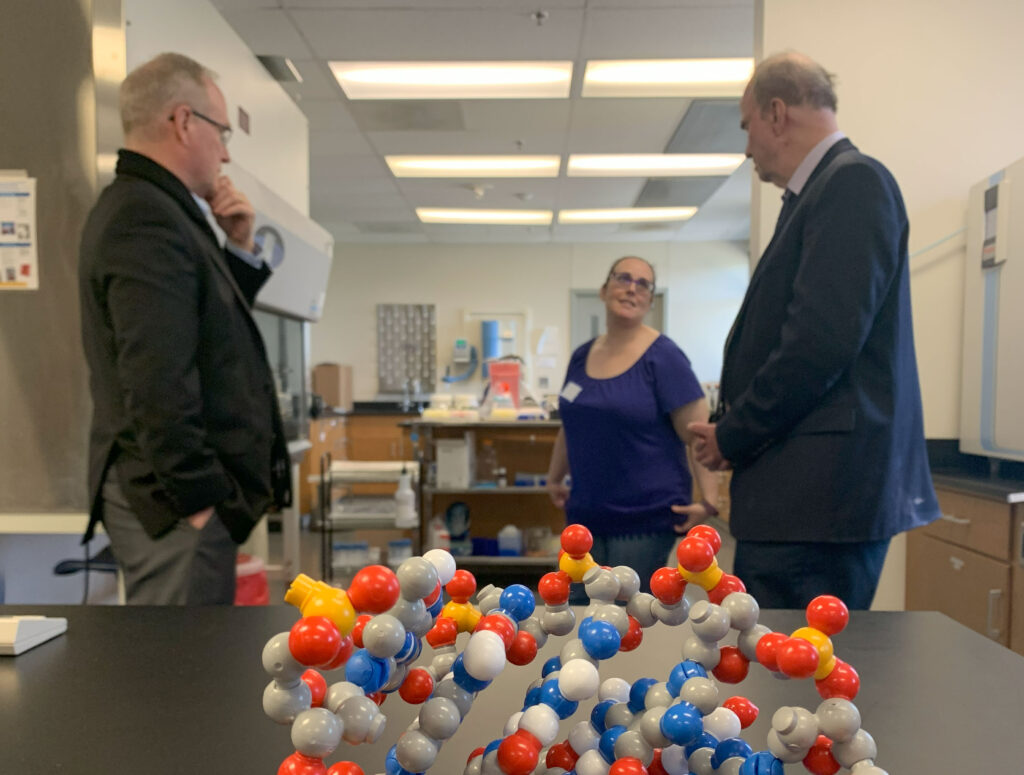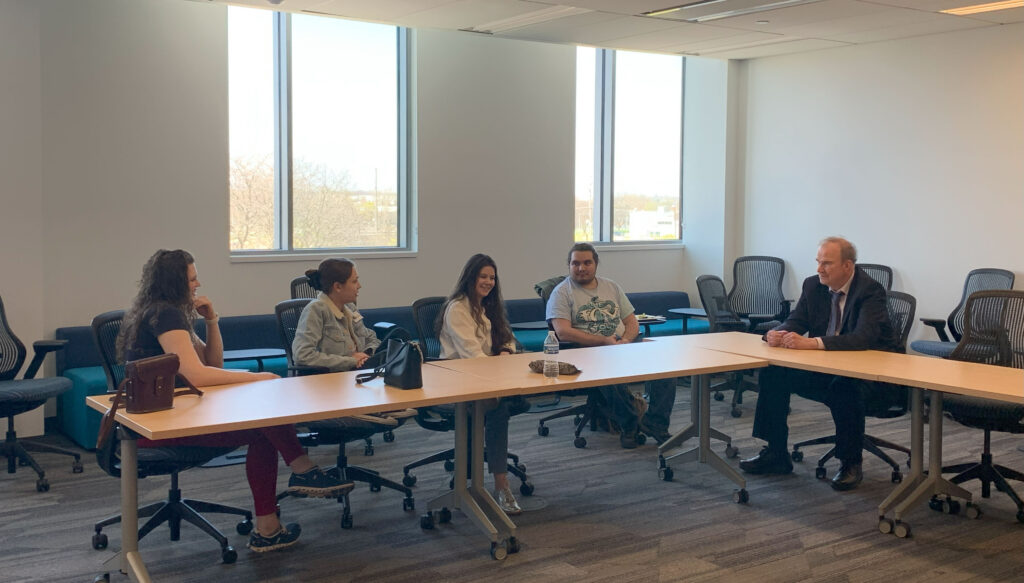On Thursday, April 27th, 2023, University of Michigan-Flint alumnus, Dallas Anderson visited his Baccalaureate alma mater. It wasn’t just a trip down memory lane, though; Anderson came as a representative of the National Institute of Aging, a division of the National Institute of Health, where he works as a program director for the Division of Neuroscience. Anderson spent the day meeting with students and faculty to talk about aging, research, and grantmaking.
Keynote
In the middle of the day, Anderson was joined by Maria Carranza, who manages the NIA’s fellowship and research career development programs for an in-depth presentation on how to navigate the complex landscape of programs, divisions, and types of grants that are offered through the NIA. Anderson talked about the processes and best practices in applying for grants.
Grant applications go through a rigorous review process and get a score based on several criteria, and that score makes the difference whether the application may get funded or not. According to Anderson, one of the most important parts of getting a payable score is to be clear about the aims of your project and have all the parts of it cohesively tie-in to those aims. Those aims are crucial and must be properly defended with a team that has the right expertise to address them, relevant preliminary data showing that the research plan is feasible, a strong analytic plan, and a realistic timeline.
Anderson explained, “it’s best to imagine the reviewer is exhausted from reading 8 large grant proposals before getting to yours… as that’s sometimes the case, SIMPLIFY your research plan.” It’s also important to justify the research in the broader landscape of the field, addressing any potential overlaps with existing grants. When it comes to key personnel on the research team, Anderson pointed out that they must have appropriate expertise related to the stated aims – it’s helpful, perhaps crucial, if they have a history of published articles in the area.
Carranza joined virtually via teleconference and spoke on the structure of the NIA, and the many various types and levels of grant packages that exist in the organization. She explained many career-development and fellowship awards that are available for faculty to pursue and gain a deeper level of knowledge and skills for aging research. She also explained that there is guidance available to help researchers find the right program and grant for their work – it’s important to apply to the most relevant part of the NIH to your specific work.
Faculty Sessions
Throughout the day surrounding this keynote presentation, though, Anderson very intently listened to UM-Flint faculty and students and asked many questions about the specifics of their research. As Joe Sucic talked about his molecular biology research, you could see Anderson’s face reflecting the map of the NIH and where the best grant matches exist for his body of work.
When Matt Fahner started talking about his research examining the degradation of Omega 3 and Omega 6 fatty acids under heat and ways we can preserve them for healthier cooking, Anderson lit up and the conversation shifted to one about aging, more generally. At his suggestion, the group watched this 12-minute clip from 60 Minutes Australia about the island of Ikaria off the coast of Greece, where the inhabitants live inordinately longer than much of the rest of the world (a Blue Zone). This led to a lot of laughter and discussion among the group, who pondered the many contradictions and peculiarities of their lifestyles. One centenarian in the clip touted the benefits of red wine and lit up a cigarette. Anderson remarked that those more inland on the island ate mostly a vegetarian diet and didn’t even travel to the coast for fish very often. One interviewee in the clip talked about how the natural landscape makes the herbs and plants there very potent. Sheryl Groden, co-director of the Center on Aging Research Cluster hosting the event, suggested that the lively social lives of the elderly folks there has a large part to do with their longevity.
Yasser Aboelkassam and Jessica Kelts spoke about their research and were met with advice from Anderson on where their research matches up with NIH programming and priorities.

Charlotte Tang, Linda Zhu, and Nathaniel Miller, who work together on the Track My PD research project and mobile app, each spoke to different facets of their work as well. Tang talked about research using wearable technology to help determine fall risk and even alert family members for aging people. Zhu explained her research into tinnitus, where she’s looking to see if there is something measurable in the auditory processing channel related to tinnitus that could lead to treatment insights in the future. Anderson and Zhu discussed the difficulties of gathering preliminary data on issues like this due to both the subjective nature of tinnitus and the fact that people tend to under-report these conditions.
When Miller circled back to talking about his Parkinson’s research, the topic remained on the subject of preliminary data. Anderson brought up a point that he needs to be sure and have diversity in the population sample for his preliminary data. “If the population is primarily educated white folks, it will be seen as a negative,” he said. The NIA, along with many other large grant funding institutions is working hard to overcome sample biases in our culture.
Michael Witt, serial entrepreneur and lecturer from the School of Management, spoke of tentative plans to work with a local specialist in Cardiology to start up a free health-care clinic for Flint-area elderly folks and study things like heart failure and readmission rate in hospitals. Anderson responded that there are specific grants that are targeted at the starting of research clinics and institutions. Among his suggestions were to make sure the research team had a decent publication record to establish themselves as experts in the field.
The last faculty member to speak ended up recalling a thematic element from the Blue-zone discussion – does a prolonged social life promote longevity? Rie Suzuki spoke to her focus on research looking to augment social experience for the elderly. She is gathering preliminary data and doing a needs assessment to look at things like internet and transportation access. She is also looking into ways that personalized communications between humans and machines can help mitigate these social issues for the elderly.
Who’s on first? – why being first author may matter
While taking a tour of some of the labs on campus, Anderson got more specific on the point of publication record. “Just one (research article) per year where the author is first author listed is good enough for most of our purposes.” This is noteworthy for UM-Flint faculty, because it is very common practice to put the students as the lead authors on papers done in conjunction with student researchers through UROP and SURE collaborations. It’s a big part of why student research experiences can be so valuable at UM-Flint, giving undergraduate students the opportunity to collaborate on research papers and presentations. Anderson said that it may be less important in some disciplines, but it would be best for researchers looking to apply for NIA grants to ensure they are first-named on at least one paper per year.
Student Sessions
In the student sessions, Anderson was quite accessible and generous in listening and advising the students he met. He explained things about the ways that the research landscape is changing. PhD student, Hannah Karczewski said “It was a very meaningful experience to have a Flint native give back to his school and community.” Anderson told the students to work toward having concise writing. To read more, to write more, and review others’ manuscripts to build their skill sets, according to Karczewski.

Brianna Rivera, molecular biology undergraduate student researcher, got the chance to share about her current research in bone tissue regeneration and her plans for after undergraduate school. “I asked (Anderson) if it was a difficult adjustment to go from our smaller campus community in Flint to Ann Arbor’s campus. He told me he very much enjoyed Ann Arbor and that it wasn’t a hard adjustment at all because in graduate school you are studying alongside a smaller cohort and everyone is very friendly and welcoming.”
Anderson recommended the students get a copy of The Elements of Style by E.B. White. He pressed upon the students that one of the most difficult and important parts of research is concise clear writing.
Anderson Remembers
Between sessions, Anderson took a walking tour of the campus. He visited a couple of the labs in our new CIT building and was far more interested in the people he met and the research they’re doing. For him, it was clear he was there to connect and give back to the school that helped guide his path. While walking across the river, Anderson gestured to the White building. “The last time I was here, that was the IMA,” he said, “which is meaningful to me because I had part of my undergraduate experience funded with a scholarship from the Industrial Mutual Association.”
Anderson studied Mathematics and graduated from UM-Flint in 1971. A lot has changed since. The IMA he mentioned was torn down in the transition to the infamous Autoworld theme park, located where the William S White building now sits. When Anderson attended UM-Flint, the campus was still situated on the current Mott Community College campus with one building and several trailers.
Since his time on our campus, Anderson went to graduate school at the University of Michigan – Ann Arbor campus and got his M.P.H and Ph.D. in Biostatistics and began his longstanding career in neuroepidemiology. He worked for years in the National Institute of Neurological and Communicative Disorders and Stroke and conducted population studies. In 2003, Anderson moved to his current home in the Extramural Program of the Division of Neuroscience at the NIA.
With all he’s done, Anderson never forgot his alma mater. In introducing him before the keynote speech, Shari Schrader, Vice Chancellor of University Advancement, noted that Anderson has been a generous alumnus contributor for over 40 years. It’s clear he’s never forgotten what he received here and that he believes in this place, this campus, and this community.
